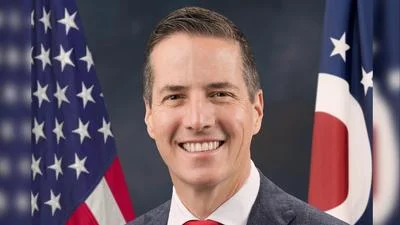Ur Mendoza Jaddou, Director of the U.S. Citizenship and Immigration Services (left) and Jennifer B. Higgins, Deputy Director. | https://www.uscis.gov/about-us/organization/leadership
Ur Mendoza Jaddou, Director of the U.S. Citizenship and Immigration Services (left) and Jennifer B. Higgins, Deputy Director. | https://www.uscis.gov/about-us/organization/leadership
All of the petitions submitted in the period were approved.
Employers are classified under industries based on their reported operations and may be involved in multiple industries.
The H-1B visa program allows U.S. employers to temporarily hire foreign workers in specialty occupations requiring specialized knowledge and at least a bachelor’s degree or equivalent. It is designed to address skill gaps in the U.S. workforce while ensuring wage standards to protect both U.S. and H-1B workers. Employers must certify that they will pay H-1B workers wages equal to or greater than those of similarly qualified U.S. employees or the prevailing local wage.
The average approval rate for H-1B petitions across the United States in 2024 stood at 98%, higher than 2023's 97.3%. Statewide, Ohio employers across all industries submitted 6,524 petitions during the same period, achieving an approval rate of 98%.
The Professional, Scientific, and Technical Services industry led the H-1B filings in Ohio during 2024, with 2,749 petitions (42.1% of all submissions), and an approval rate of 97.2%. Meanwhile, the Manufacturing industry was the second largest contributor, filing 944 petitions (14.5% of the total), with an approval rate of 98.5%.
The Ohio employers which made the most petitions in the Public Administration sector during 2024 included Caresource Management Services, LLC with 32 petitions, Mid Ohio Regional Planning Commission with three petitions, and State of Ohio Department of Administrative Services with two petitions.
Compared to 2023, the Public Administration sector in Ohio saw a 7.1% increase in the number of H-1B petitions during 2024.
The United States admits around 1 million legal immigrants annually, most of whom receive permanent residence (green cards) through family sponsorship or employment-based visas. In 2023, about 1.2 million immigrants were granted green cards, a return to pre-pandemic levels. Temporary visa programs, such as the H-1B for highly skilled workers and H-2A for seasonal agricultural workers, also play a critical role in filling workforce needs.
Public opinion on immigration varies, with 46% of Americans favoring maintaining current legal immigration levels, according to a 2024 Pew Research Center survey. Additionally, 42% believe that highly skilled workers, such as scientists, doctors, and programmers, should be prioritized for legal immigration, compared to 25% who prioritize workers filling labor shortages and 19% who emphasize family sponsorship. Despite this, family sponsorship remains the most common path to permanent residency, accounting for 63% of green cards issued in 2023.
The data in this article comes from the H-1B Employer Data Hub provided by the U.S. Citizenship and Immigration Services (USCIS). While USCIS strives for accuracy, manual data entry and errors on paper forms submitted by applicants or petitioners may result in discrepancies in employer names, tax IDs, locations, or other details.
| Rank | Industry | Total Petitions | % of All Submissions | % Approved | % Denied |
|---|---|---|---|---|---|
| 1 | Professional, Scientific, and Technical Services | 2,749 | 42.1% | 97.2% | 2.8% |
| 2 | Manufacturing | 944 | 14.5% | 98.5% | 1.5% |
| 3 | Health Care and Social Assistance | 781 | 12% | 98.6% | 1.4% |
| 4 | Educational Services | 682 | 10.5% | 98.8% | 1.2% |
| 5 | Finance and Insurance | 471 | 7.2% | 99.4% | 0.6% |
| 6 | Retail Trade | 254 | 3.9% | 98.8% | 1.2% |
| 7 | Wholesale Trade | 195 | 3% | 99% | 1% |
| 8 | Information | 102 | 1.6% | 96.1% | 3.9% |
| 9 | Administrative and Support and Waste Management and Remediation Services | 76 | 1.2% | 97.4% | 2.6% |
| 10 | Transportation and Warehousing | 55 | 0.8% | 96.4% | 3.6% |
| 11 | Public Administration | 45 | 0.7% | 100% | 0% |
| 12 | Other Services (except Public Administration) | 43 | 0.7% | 100% | 0% |
| 13 | Construction | 35 | 0.5% | 100% | 0% |
| 14 | Real Estate and Rental and Leasing | 26 | 0.4% | 100% | 0% |
| 15 | Utilities | 24 | 0.4% | 100% | 0% |
| 16 | Accommodation and Food Services | 13 | 0.2% | 92.3% | 7.7% |
| 16 | Arts, Entertainment, and Recreation | 13 | 0.2% | 100% | 0% |
| 18 | Management of Companies and Enterprises | 8 | 0.1% | 100% | 0% |
| 19 | Agriculture, Forestry, Fishing and Hunting | 6 | 0.1% | 83.3% | 16.7% |
| 20 | Mining, Quarrying, and Oil and Gas Extraction | 2 | 0% | 100% | 0% |
Top Employers in Public Administration Industry in Ohio, 2024
| Rank | Company Name | Total Petitions | % Approved | % Denied |
|---|---|---|---|---|
| 1 | Caresource Management Services, LLC | 32 | 100% | 0% |
| 2 | Mid Ohio Regional Planning Commission | 3 | 100% | 0% |
| 3 | State of Ohio Department of Administrative Services | 2 | 100% | 0% |
| 4 | Lucas County Auditor | 1 | 100% | 0% |
| 4 | State of Ohio Opportunities for Ohioans With Disabilities | 1 | 100% | 0% |
| 4 | Jefferson Health Plan | 1 | 100% | 0% |
| 4 | Cuyahoga Metropolitan Housing Authority | 1 | 100% | 0% |
| 4 | Ohio Department of Transportation | 1 | 100% | 0% |
| 4 | City of Cleveland | 1 | 100% | 0% |
| 4 | Neptune Equipment Company D B a NE | 1 | 100% | 0% |
| 4 | Mahoning County Public Health | 1 | 100% | 0% |






 Alerts Sign-up
Alerts Sign-up